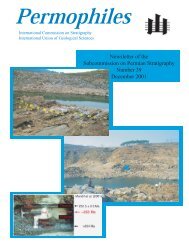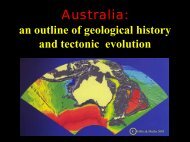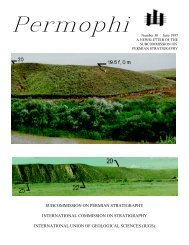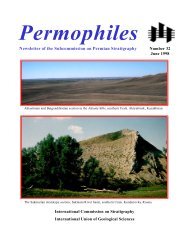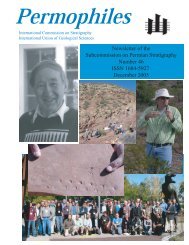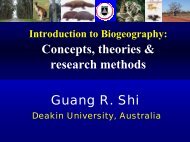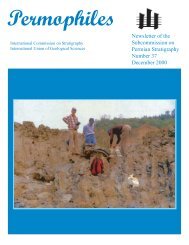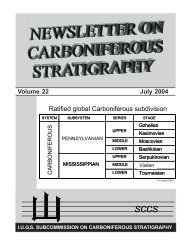Number 31 January 1998 Newsletter of the Subcommission on ...
Number 31 January 1998 Newsletter of the Subcommission on ...
Number 31 January 1998 Newsletter of the Subcommission on ...
You also want an ePaper? Increase the reach of your titles
YUMPU automatically turns print PDFs into web optimized ePapers that Google loves.
pati<strong>on</strong> and exchange <str<strong>on</strong>g>of</str<strong>on</strong>g> newsletters. Thailand is <str<strong>on</strong>g>the</str<strong>on</strong>g> developing<br />
country c<strong>on</strong>tributing a lot in organizing GEOTHAI’97 meeting.<br />
3. Proposed Activities <str<strong>on</strong>g>of</str<strong>on</strong>g> <str<strong>on</strong>g>the</str<strong>on</strong>g> Project for <str<strong>on</strong>g>the</str<strong>on</strong>g> Year Ahead<br />
Because <str<strong>on</strong>g>the</str<strong>on</strong>g> project will close by <str<strong>on</strong>g>the</str<strong>on</strong>g> end <str<strong>on</strong>g>of</str<strong>on</strong>g> this year, no new<br />
activities have been proposed. The Chinese members are drafting<br />
<str<strong>on</strong>g>the</str<strong>on</strong>g> first circular <str<strong>on</strong>g>of</str<strong>on</strong>g> a Permo-Triassic meeting to be held in<br />
<str<strong>on</strong>g>the</str<strong>on</strong>g> spring <str<strong>on</strong>g>of</str<strong>on</strong>g> 1999. If a successive project is established, that<br />
meeting will naturally become a part <str<strong>on</strong>g>of</str<strong>on</strong>g> <str<strong>on</strong>g>the</str<strong>on</strong>g> new project. The<br />
meeting <str<strong>on</strong>g>of</str<strong>on</strong>g> Shallow Tethys 5, in close c<strong>on</strong>necti<strong>on</strong> with our project,<br />
will be held in Chiang Mai, Thailand, 1-5 February, 1999 (corresp<strong>on</strong>dence:<br />
Dept. Geol. Sci., Faculty Science, Chiang Mai Univ.,<br />
Chiang Mai, Thailand).<br />
4. Intenti<strong>on</strong> to Propose Successor Project.<br />
In 1996 Dr. Trinh Dzanh, director <str<strong>on</strong>g>of</str<strong>on</strong>g> <str<strong>on</strong>g>the</str<strong>on</strong>g> Geological Museum<br />
<str<strong>on</strong>g>of</str<strong>on</strong>g> Vietnam, and Dr. Phan Cu Tien, director <str<strong>on</strong>g>of</str<strong>on</strong>g> Geological Research<br />
Institute <str<strong>on</strong>g>of</str<strong>on</strong>g> Vietnam, have suggested a project <strong>on</strong> <str<strong>on</strong>g>the</str<strong>on</strong>g><br />
geological development and mineral resources<str<strong>on</strong>g>of</str<strong>on</strong>g> SE Asia emphasizing<br />
Late Palaeozoic and Early Mesozoic. In <str<strong>on</strong>g>the</str<strong>on</strong>g> workshop<br />
meeting held during <str<strong>on</strong>g>the</str<strong>on</strong>g> GEOTHAI’97 meeting, Dr. John<br />
Rigby was chosen to c<strong>on</strong>tact <str<strong>on</strong>g>the</str<strong>on</strong>g> Vietnamese specialists and to<br />
raise a proposal <str<strong>on</strong>g>of</str<strong>on</strong>g> <str<strong>on</strong>g>the</str<strong>on</strong>g> successor project.<br />
5. Summary<br />
A number <str<strong>on</strong>g>of</str<strong>on</strong>g> regi<strong>on</strong>al stratigraphic charts covering large parts<br />
<str<strong>on</strong>g>of</str<strong>on</strong>g> Tethys, Circum-Pacific and marginal G<strong>on</strong>dwana have been<br />
submitted and discussed and o<str<strong>on</strong>g>the</str<strong>on</strong>g>r are being compiled. Major<br />
progress has been achieved in <str<strong>on</strong>g>the</str<strong>on</strong>g> research <strong>on</strong> intersystem and<br />
intrasystem boundaries <str<strong>on</strong>g>of</str<strong>on</strong>g> Permian and Triassic. This project<br />
has been recognized as a dynamic working group toward a<br />
comprehensive correlati<strong>on</strong> <str<strong>on</strong>g>of</str<strong>on</strong>g> Permian and Triassic and compilati<strong>on</strong><br />
<str<strong>on</strong>g>of</str<strong>on</strong>g> researches <strong>on</strong> <str<strong>on</strong>g>the</str<strong>on</strong>g> global changes that occurred during<br />
this important geological period for a better understanding <str<strong>on</strong>g>of</str<strong>on</strong>g><br />
<str<strong>on</strong>g>the</str<strong>on</strong>g> past, present and future <str<strong>on</strong>g>of</str<strong>on</strong>g> <str<strong>on</strong>g>the</str<strong>on</strong>g> world.<br />
President Yin H<strong>on</strong>gfu<br />
China University <str<strong>on</strong>g>of</str<strong>on</strong>g> Geosciences<br />
Wuhan Hubei,430074 China<br />
ph<strong>on</strong>e:086-27-7806-812 (H) Fax: 086-27-7801-763<br />
hfyin@dns.cug.edu.cn<br />
Upper Carb<strong>on</strong>iferous and Lower Permian Stratigraphic<br />
Studies: Sou<str<strong>on</strong>g>the</str<strong>on</strong>g>rn Ural Mountains, Russia<br />
and Kazakstan. Summary <str<strong>on</strong>g>of</str<strong>on</strong>g> <str<strong>on</strong>g>the</str<strong>on</strong>g> 1997 Field Seas<strong>on</strong>:<br />
Permian Research Institute, Boise, Idaho,<br />
USA and VSEGEI, St. Petersburg, Russia.<br />
by Dale A. Kerner, Vladimir I. Davydov and Kyle Graff<br />
Upper Carb<strong>on</strong>iferous and Lower Permian strata <str<strong>on</strong>g>of</str<strong>on</strong>g> <str<strong>on</strong>g>the</str<strong>on</strong>g> Urals<br />
have historically been <str<strong>on</strong>g>of</str<strong>on</strong>g> great importance to <str<strong>on</strong>g>the</str<strong>on</strong>g> establishment<br />
<str<strong>on</strong>g>of</str<strong>on</strong>g> Permian chr<strong>on</strong>ostratigraphic divisi<strong>on</strong>s. The Permian Research<br />
Institute (PRI) <str<strong>on</strong>g>of</str<strong>on</strong>g> Boise State University jointly with VSEGEI<br />
and <str<strong>on</strong>g>the</str<strong>on</strong>g> Pale<strong>on</strong>tological Institute <str<strong>on</strong>g>of</str<strong>on</strong>g> <str<strong>on</strong>g>the</str<strong>on</strong>g> RAN have been c<strong>on</strong>ducting<br />
field studies in <str<strong>on</strong>g>the</str<strong>on</strong>g> sou<str<strong>on</strong>g>the</str<strong>on</strong>g>rn Ural mountains <str<strong>on</strong>g>of</str<strong>on</strong>g> Russia<br />
39<br />
and Kazakstan since 1991. Strata <str<strong>on</strong>g>of</str<strong>on</strong>g> <str<strong>on</strong>g>the</str<strong>on</strong>g> Pre-Uralian foredeep<br />
provide <str<strong>on</strong>g>the</str<strong>on</strong>g> body and boundary stratotypes for most <str<strong>on</strong>g>of</str<strong>on</strong>g><br />
Cisuralian (Lower Permian) Series, c<strong>on</strong>sisting <str<strong>on</strong>g>of</str<strong>on</strong>g> <str<strong>on</strong>g>the</str<strong>on</strong>g> Asselian,<br />
Sakmarian, Artinskian, and Kungurian stages. The Kungurian<br />
represented <str<strong>on</strong>g>the</str<strong>on</strong>g> original base <str<strong>on</strong>g>of</str<strong>on</strong>g> <str<strong>on</strong>g>the</str<strong>on</strong>g> Permian System (Murchis<strong>on</strong>,<br />
1841), and SPS has determined to preserve <str<strong>on</strong>g>the</str<strong>on</strong>g> name for <str<strong>on</strong>g>the</str<strong>on</strong>g><br />
uppermost stage <str<strong>on</strong>g>of</str<strong>on</strong>g> <str<strong>on</strong>g>the</str<strong>on</strong>g> Cisuralian; however, <str<strong>on</strong>g>the</str<strong>on</strong>g> Kungurian<br />
stratotype will be elsewhere. Numerous sites in <str<strong>on</strong>g>the</str<strong>on</strong>g> regi<strong>on</strong> also<br />
exhibit well exposed Upper Carb<strong>on</strong>iferous strata. The Carb<strong>on</strong>iferous-Permian<br />
boundary Global Stratotype Secti<strong>on</strong> and Point<br />
(GSSP) has recently been established at Aidaralash Creek.<br />
Current focus <str<strong>on</strong>g>of</str<strong>on</strong>g> <str<strong>on</strong>g>the</str<strong>on</strong>g> studies in <str<strong>on</strong>g>the</str<strong>on</strong>g> regi<strong>on</strong> by PRI and o<str<strong>on</strong>g>the</str<strong>on</strong>g>rs<br />
is <str<strong>on</strong>g>the</str<strong>on</strong>g> ultimate establishment <str<strong>on</strong>g>of</str<strong>on</strong>g> stratotypes and precise<br />
chr<strong>on</strong>ostratigraphic stage and substage boundaries for all<br />
Cisuralian stages and substages, based <strong>on</strong> biostratigraphic and<br />
sequence stratigraphic data. Both serve as powerful tools for<br />
correlating Cisuralian stages worldwide through recogniti<strong>on</strong> <str<strong>on</strong>g>of</str<strong>on</strong>g><br />
widely distributed faunal and eustatic sequence boundaries.<br />
To accomplish this, paleogeographic rec<strong>on</strong>structi<strong>on</strong>s are required<br />
in order to understand <str<strong>on</strong>g>the</str<strong>on</strong>g> nature <str<strong>on</strong>g>of</str<strong>on</strong>g> sequence boundaries<br />
in <str<strong>on</strong>g>the</str<strong>on</strong>g> regi<strong>on</strong>, and to determine whe<str<strong>on</strong>g>the</str<strong>on</strong>g>r <str<strong>on</strong>g>the</str<strong>on</strong>g>y are predominantly<br />
eustatically or tect<strong>on</strong>ically c<strong>on</strong>trolled.<br />
During <str<strong>on</strong>g>the</str<strong>on</strong>g> 1997 field seas<strong>on</strong> in <str<strong>on</strong>g>the</str<strong>on</strong>g> sou<str<strong>on</strong>g>the</str<strong>on</strong>g>rn Urals, thirteen<br />
stratigraphic secti<strong>on</strong>s were visited and sampled; four were measured<br />
and described in detail. Figure1 shows <str<strong>on</strong>g>the</str<strong>on</strong>g> locati<strong>on</strong> <str<strong>on</strong>g>of</str<strong>on</strong>g><br />
some <str<strong>on</strong>g>of</str<strong>on</strong>g> <str<strong>on</strong>g>the</str<strong>on</strong>g> stratigraphic secti<strong>on</strong>s studied in 1997, and those<br />
measured and described during PRI’s prior field seas<strong>on</strong>s. A<br />
primary goal <str<strong>on</strong>g>of</str<strong>on</strong>g> <str<strong>on</strong>g>the</str<strong>on</strong>g> 1997 field seas<strong>on</strong> was detailed resampling<br />
for c<strong>on</strong>od<strong>on</strong>ts, fusulinids, amm<strong>on</strong>oids and palynomorphs <str<strong>on</strong>g>of</str<strong>on</strong>g><br />
several previously measured secti<strong>on</strong>s. Ash beds were also<br />
sampled for absolute dating <str<strong>on</strong>g>of</str<strong>on</strong>g> key intervals <str<strong>on</strong>g>of</str<strong>on</strong>g> critical secti<strong>on</strong>s.<br />
In additi<strong>on</strong>, several secti<strong>on</strong>s were measured, described, and<br />
sampled by PRI for <str<strong>on</strong>g>the</str<strong>on</strong>g> first time.<br />
The ultimate goal <str<strong>on</strong>g>of</str<strong>on</strong>g> our current research in <str<strong>on</strong>g>the</str<strong>on</strong>g> Ural Mountains<br />
is <str<strong>on</strong>g>the</str<strong>on</strong>g> establishment <str<strong>on</strong>g>of</str<strong>on</strong>g> globally accepted Cisuralian stage<br />
and substage boundaries and body stratotypes. Recent ratificati<strong>on</strong><br />
<str<strong>on</strong>g>of</str<strong>on</strong>g> <str<strong>on</strong>g>the</str<strong>on</strong>g> secti<strong>on</strong> at Aidaralash Creek as <str<strong>on</strong>g>the</str<strong>on</strong>g> Lower Permian<br />
GSSP is <strong>on</strong>e step towards this goal. To achieve globally accepted<br />
stage and substage boundaries, candidate stratigraphic<br />
secti<strong>on</strong>s must be well studied and documented to c<strong>on</strong>form with<br />
guidelines set forth by <str<strong>on</strong>g>the</str<strong>on</strong>g> Internati<strong>on</strong>al Commissi<strong>on</strong> <strong>on</strong> Stratigraphy.<br />
The primary management vehicle for such extensive sampling<br />
and detailed measurement and descripti<strong>on</strong> <str<strong>on</strong>g>of</str<strong>on</strong>g> secti<strong>on</strong>s is a<br />
biostratigraphic and lithostratigraphic database that we are developing<br />
for <str<strong>on</strong>g>the</str<strong>on</strong>g> sou<str<strong>on</strong>g>the</str<strong>on</strong>g>rn Ural Mountains, which will also include<br />
sequence stratigraphic data.<br />
Preliminary sequence stratigraphic correlati<strong>on</strong>s attempted for<br />
secti<strong>on</strong>s in <str<strong>on</strong>g>the</str<strong>on</strong>g> sou<str<strong>on</strong>g>the</str<strong>on</strong>g>rn Urals compared with <str<strong>on</strong>g>the</str<strong>on</strong>g> global sea<br />
level curves <str<strong>on</strong>g>of</str<strong>on</strong>g> Ross and Ross (1988) suggest that depositi<strong>on</strong>al<br />
rates in <str<strong>on</strong>g>the</str<strong>on</strong>g> pre-Ural foredeep were not uniform al<strong>on</strong>g <str<strong>on</strong>g>the</str<strong>on</strong>g> entire<br />
foreland basin. What remains poorly understood is to what<br />
relative extent tect<strong>on</strong>ics and eustacy have played in <str<strong>on</strong>g>the</str<strong>on</strong>g> formati<strong>on</strong><br />
<str<strong>on</strong>g>of</str<strong>on</strong>g> <str<strong>on</strong>g>the</str<strong>on</strong>g> observed sequences. These problems need to be<br />
resolved before worldwide correlati<strong>on</strong> can be achieved. Numerical<br />
dates fully integrated with biostratrigraphy for Cisuralian<br />
type secti<strong>on</strong>s will provide important data points.<br />
Special thanks are extended to Academician A. D. Shcheglev,<br />
Director <str<strong>on</strong>g>of</str<strong>on</strong>g> VSEGEI, and to Dr. Bruce R. Wardlaw for cooperative<br />
support <str<strong>on</strong>g>of</str<strong>on</strong>g> our field efforts.



